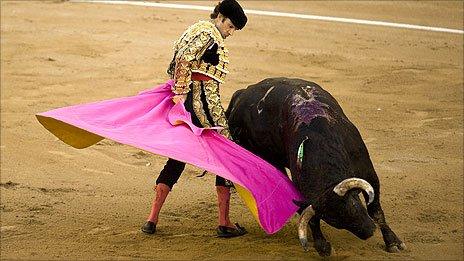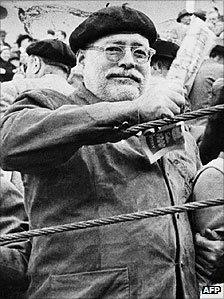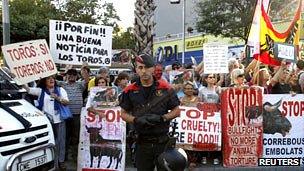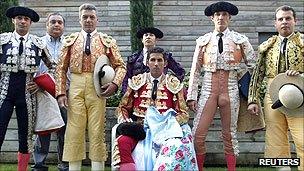Barcelona's last bullfight
- Published

The Catalan parliament voted to ban bullfighting from January 2012
Barcelona has staged its final bullfight after Catalonia became the first region in Spain to ban the traditional spectacle.
They came from all over - serious men from Seville and Madrid filling trains and planes with their fine suits and Havana cigars, their tanned and buffed consorts in tow.
The flamboyant French had poured down over the border to celebrate "Los Toros" with extravagant "ole's and elegant wines.
Studious Americans, wealthy Mexicans, Basques and Swedes - even the sole Japanese torero, El Nino del Sol Naciente (the son of the rising sun), was among those who had managed to secure the scorching-hot tickets for the big show in town.
The last show in town - ever.
I did not spot any other Englishmen among the 20,000 aficionados packed into the Monumental, Barcelona's beautiful Art Nouveau bull-ring.
'Feted killers'
I had come here as a form of pilgrimage to the place where I had first fallen in love with the brutal beauty of this age-old ritual, when I lived here as a romantic young Hispanophile back in the 1980s.

Ernest Hemingway's passion for bullfighting inspired two of his books
Three hundred or so corridas (bullfights) - and even more arguments with my uncomprehending and often appalled countrymen - later, I felt the need to be there at the death, so to speak.
Influenced by Hemingway and Picasso, I was taken all those years ago by the potent metaphor of man against nature, and the stirring displays of grace under pressure, as the matadors - the gilded and feted killers - attempted to create fleeting, fluid beauty with the doomed beast.
Watching man and animal become one in this highly stylised dance of death was the most intense and life-affirming experience I had ever witnessed.
And to this day, I am entranced every time a paso doble plays and a man in a glittering suit steps onto the sand, with one of the most powerful and deadly champions nature can provide, before hopefully providing a swift and fitting end, all the while placing his own life on the line.
To me it is undoubtedly an art form and one intrinsically linked with my love of the dark and intense culture of Spain, one of the things which still marks out this unique and magnetic land as so different from its European neighbours.
Torture and culture
But I am also acutely aware that the bloody public slaughter of noble animals for my entertainment is seen by many as a disgrace, a cruel anachronism and a stain on modern Spain, which should be banned completely.

A campaign by animal rights protesters was the catalyst for the ban
I may have been the only Englishman in the plaza, but outside, I suspect, there was at least one fellow countryman among the surprisingly small but jubilantly vocal group of antitaurinos who had gathered opposite the ring.
He held up a sign which read in English "Never again" and gave a uniquely English hand gesture to the few bullfight fans who bothered to argue with the 50 or so "antis", who were outnumbered by the stern-looking riot police who surrounded them.
Theirs was not so much a demonstration as a celebration of victory, their job having been done a year ago when the Catalan parliament voted to ban the corrida throughout the province. It was never a hotbed of taurine activity, but had seen regular fights in the Barcelona plaza for 97 years.
The animal rights view - enshrined in the chanted slogan "La tortura no es cultura" (torture is not culture) - is undoubtedly held by many Catalans, and the ring has long been in slow decline, as a young generation of funky, "European" Barcelonans turned their backs on the bulls.
Snub to Spain
But it was the complex politics of Iberian separatism which actually put paid to Barcelona's bull-ring.
Ever since the terrible Civil war and its long aftermath under General Franco when Barcelona - the most vehemently republican of cities - was viciously repressed and its culture and language suppressed, many Catalans have grown to despise Spain and everything associated with it.
This is a bitter enmity played out every time Barcelona and Real Madrid meet at football, as Real were General Franco's favourite team.
It is also a profound culture clash, because Barcelona sees itself as modern and forward-looking while Madrid believes it is the keeper of the traditional Spanish soul.
Snubbing "Spain" and distancing Catalonia by outlawing such a vividly "Spanish" tradition was the real motive for many of the nationalist politicians who took that historic vote.
There was certainly a heightened sense of history and emotion among the crowds who watched the three matadors dance with and then dispatch six bulls in the time-honoured fashion.
A 'good kill'
The atmosphere and noise were extraordinary with a febrile, sometimes angry edge, unusual in a bull-ring.
The whole event was interspersed with cries of "Viva la fiesta" and even "Viva Espana" from the stands, many of which were draped in banners and flags.
One of them read "Libertad de expresion, Libertad de creacion" (liberty of expression, liberty of creation). Another simply proclaimed "Continuara" (it will continue).

Serafin Marin (seated) was given the honour of being the last matador to face a bull
The matadors present included Jose Tomas, the most charismatic and enigmatic torero of his generation, and a man who has come close to death so many times that his every appearance is fraught with tension.
His close, smooth and vividly dangerous, yet somehow calm and gentle performance was judged the great triumph of the afternoon.
He extracted long soft "ole's from the crowd and an award of two ears from his expertly executed animal, the traditional award for a flawless kill.
And as he slowly paraded the ring for the last time, cradling the many flowers thrown to him from the stands, people around me - some of them hardened veterans of many a bloody afternoon - had tears in their eyes.
For they understand the true worth of a good kill, a perfect end to these splendid animals who have lived free lives to the age of at least four, grazing wild on Spain's finest pasture.
The applause for a brave and strong bull is as loud as the reception given to a good matador. The Spanish do not say "We are going to see the matadors" but "We are going to see the bulls".
But no longer, in Catalonia.
Lap of honour
With great significance, the final matador to perform was Serafin Marin, the only Catalan to currently wear the suit of lights, and a young man who was visibly shaken throughout the evening.
After an expert sword at "la hora de verdad" (the moment of truth), he bowed and then prostrated himself on the sand, sobbing. He cupped the golden dust and kissed it with elaborate passion, a baroque gesture somehow fitting such an impassioned evening.
All three matadors were then raised onto the shoulders of the fans who swarmed the arena, and given a tumultuous lap of honour accompanied by the ritual chanting of "Torero, torero".
Then somehow the chant morphed into "Libertad, libertad" and continued as the matadors were carried into the packed street outside.
For a while, the chanting swelled and a small demonstration looked like it might turn ugly, but it soon dissipated into the warm, late September evening, as the thousands of aficionados retired to bars and restaurants to discuss the significance of the tumultuous events.
Most were not even from here and so knew that they could continue their passion in their own, more pro-taurine towns further south.
The local fans were more upset but could not deny that Barcelona had fallen out of love with the bulls and that the vast majority would not miss it.
I personally thought of the poet Lorca who, back in the 1930s had called the corrida "the last serious thing in the modern world".
I wondered what he would make of a world so modern that it had no place for such a visceral but potent ritual. I also wondered what would become of the great ring, which now had no function.
There was once a second bull-ring in Barcelona, which sat idle for many years until it was transformed recently by the feted British architect, Richard Rogers, into a swanky shopping centre.
How to listen to From Our Own Correspondent:
BBC Radio 4:
A 30-minute programme on Saturdays, 1130.
Second 30-minute programme on Thursdays, 1100 (some weeks only).
Listen online or download the podcast
BBC World Service:
Hear daily 10-minute editions Monday to Friday, repeated through the day, also available to listen online.
Read more or explore the archive, external at the programme website, external.